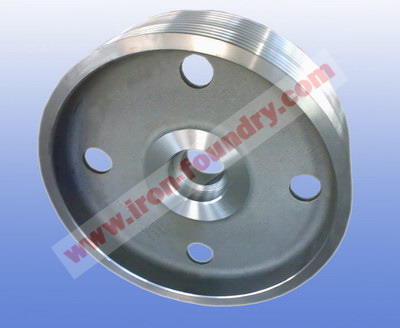Casting Process of Grey Iron Belt Pulley
Grey iron belt pulley is a kind of
iron casting with very high
technical requirements. We talked about its casting process by an
example of material ASTM A48
CLASS 35, weight 1500 kg and outside diameter 1100mm.
Normally, the belt pulley
requires machining to all surfaces, and no defects on the surfaces
of grooves and axle hole. The hardness of casting body should be
within HB 170 to HB 210.
By normal casting process, you will find there are many
iron casting defects
such as large sand holes and air holes on the surfaces, and serious
shrinkage at the gate positions. Therefore, we used the improved
casting process to solve these problems.
1. Resin sand casting process
Resin sand casting process could keep
the good surface quality and reduce the sand residuals, and meet the
high dimensional tolerance. As for the large belt pulley, this
process will be the best foundry process.
2. Use the reinforced sand boxes
Since there are large shrinkage during
cooling period, the sand boxes must be very strong to reduce the
swelling amount during pouring.
3. Large casting heads
Casting heads must be very large to meet
the demand of feeding. Although large casting heads will increase
the production costs, but this is very necessary to reduce the
shrinkage defects.
4. Use cold iron (chilling block)
Putting the cold irons at the proper
positions could effectively reduce the shrinkage. Using cold irons
will increase the production costs too, and cause more difficulties
to production. However, as for the large belt pulley, chilling block
is necessary.
5. Use air venting bars
Dandong Foundry
used 8 air venting bars on the top surfaces of belt pulley. This
process could efficiently vent the air, so to reduce the air holes.
6. Melting process
In order to meet the mechanical
properties and density of ASTM A48 NO.35, we added alloy Cu and Cr.
The final hardness of casting bodies could reach HB 170 to 190. The
melting temperature should be controlled within 1290 to 1310
Celsius.
The improved casting process could make the belt pulley castings
with better surface quality and less casting defects. After
machining, there is no defects on the machining surfaces. The
mechanical properties could meet the technical requirement of
clients.

Home |
More Articles |
